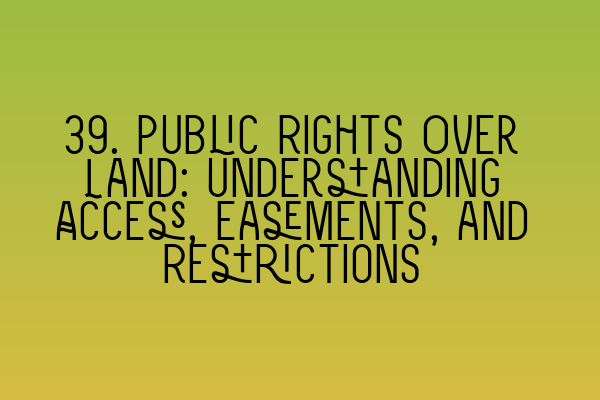39. Public Rights Over Land: Understanding Access, Easements, and Restrictions
Welcome to the latest blog post from SQE Property Law & Land Law. In today’s post, we will be exploring the fascinating topic of public rights over land, specifically focusing on access, easements, and restrictions. Understanding the intricacies of these legal concepts is essential for property owners, developers, and anyone involved in the property industry.
Before we delve into the details, it’s important to note that if you are preparing for the SQE 1 exam, we highly recommend checking out our SQE 1 Practice Exam Questions and SQE 1 Practice Mocks FLK1 FLK2 resources, which will help you solidify your understanding of property law.
Access Rights: The Key to Navigating Public and Private Land
Access to land is a fundamental aspect of property ownership and usage. Individuals may have various access rights over land, which can be granted either expressly or impliedly. Public rights of access allow the general public to use certain land for particular purposes, such as the right to walk along a designated path or the right to fish in a public river.
One common type of access right is the right of way. This grants individuals the right to pass over another person’s land, either on foot or by vehicle. The creation of a right of way can occur in several ways, including through express grant, longstanding usage, or as an incident of ownership of land.
It’s worth noting that restrictions may be imposed on public access rights. Restrictive covenants, for example, can be attached to land to limit the activities that can be carried out on it. These restrictions can help maintain the value and enjoyment of the property.
Easements: Ensuring Ease of Use and Enjoyment
An easement is a legal right that grants one person the right to use another person’s land for a specific purpose. The owner of the land where the easement is granted is known as the servient owner, while the person benefiting from the easement is the dominant owner.
Easements come in various forms and serve different purposes. Some common examples include rights of way, drainage rights, and rights to light. These types of easements are often crucial for the effective use and enjoyment of land.
Understanding the creation, scope, and extinguishment of easements is essential for property law practitioners and those involved in property transactions. Our comprehensive SQE 2 Preparation Courses cover all major aspects of property law, including easements.
Restrictions on Land: Protecting Interests and Preserving Order
Restrictions placed on land can serve various purposes, such as protecting the interests of particular parties or preserving the harmonious use of land within a community or development. Common types of land restrictions include planning restrictions, leasehold restrictions, and covenant restrictions.
Planning restrictions are imposed by local authorities to regulate land use, ensuring that it aligns with development plans and protects the interests of both the community and the environment. These restrictions can limit the types of structures that can be built, the activities that can be carried out, and the overall aesthetics of the area.
Leasehold restrictions are often found in lease agreements, and they place certain limitations on the lessee’s use of the property. These restrictions could include restrictions on subletting, alterations, or noise levels to maintain the peace and enjoyment of neighboring occupants.
Last but not least, covenant restrictions are powerful legal mechanisms that can limit land usage and enforce certain requirements. These restrictions can cover a wide range of issues, such as architectural style, maintenance obligations, or the prohibition of certain activities within a development.
If you are preparing for the SQE 1 exam and looking for a comprehensive overview of property law, our SQE 1 Preparation Courses are designed to equip you with the knowledge and skills necessary to excel in your exams.
Conclusion
Understanding public rights over land, such as access, easements, and restrictions, is crucial for anyone involved in property law and the wider property industry. Whether you are a property owner, developer, or aspiring property law practitioner, having a solid understanding of these concepts will help you navigate the legal complexities of land use and ownership.
If you are preparing for the SQE exams, make sure to check out our SRA SQE Exam Dates, so you can plan your studies efficiently and stay on track.
Thank you for reading our blog post today. For more informative articles and resources, make sure to follow our blog and explore our website. If you have any questions or need assistance, don’t hesitate to contact us. SQE Property Law & Land Law is here to help you succeed in your property law journey.
